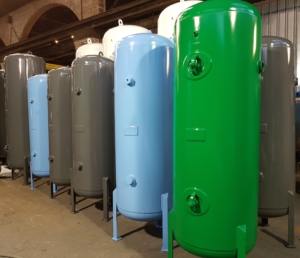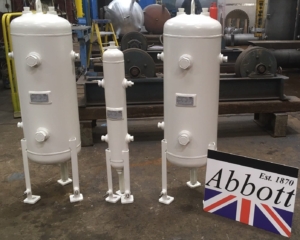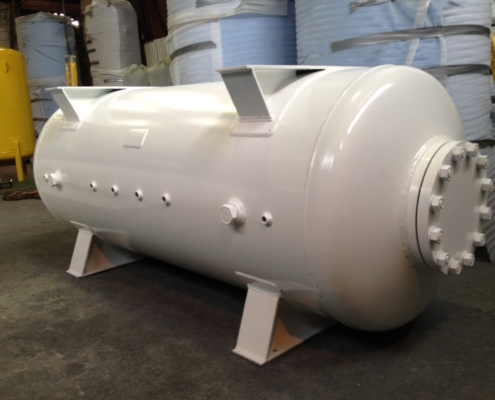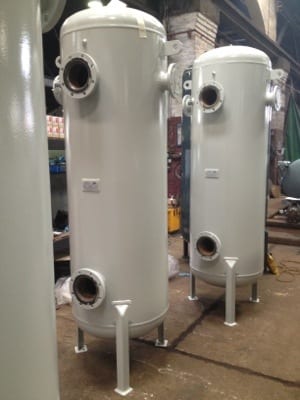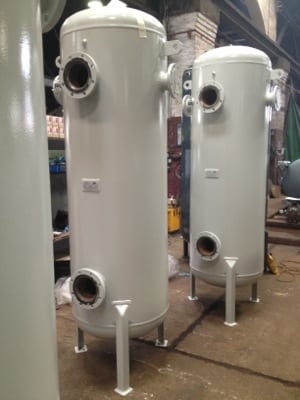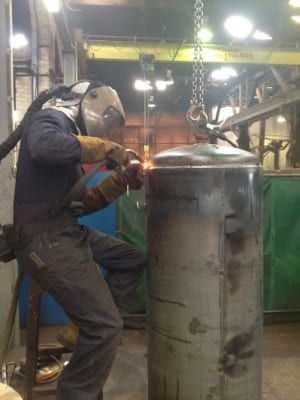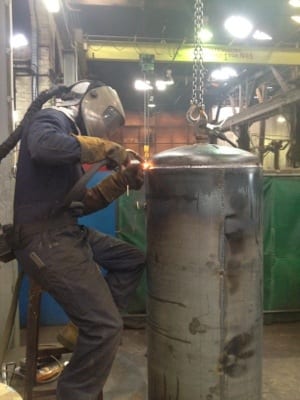Air Receivers
We offer a standard range of Air Receivers from 50 to 20 000 litres with existing approved designs, fully-compliant with UKCA UKNI and CE requirements.
Sizes up to 2720 litre held in stock and available for quick delivery.
Email or ring 01636 704208 with your enquiries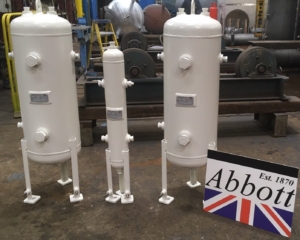
Special air receivers and larger units built to your requirements
Maximum Working Pressure
Design Pressures of 11 and 16 bar available ex-stock. Need a higher pressure? No problem, we can design and manufacture bespoke pressure vessels to meet your specific requirements.
Design Codes
Air Receivers and Pressure vessels can be built to BS 5169, BS EN 13445, EN 286, ASME, PD 5500, DNV, AD2000 AD Merkblatter, CODAP 95, CODETI 95, TRD, TRG. Compliance with PESR 2016, UKCA, UKNI, 94/55/EC, 76/767, PED, SPVD, 87/404/EEC/
Special Air Receivers
We also manufacture non standard Air Receivers and other pressure vessels to customer requirements. We are pleased to receive your enquiries for all sizes up to around 70m³ including horizontal arrangement and high pressure applications.
Email or ring 01636 704208 with your enquiries
Inlet & Outlet Connections
BSPT or NPT female sockets or flanged to EN1092-1 BS4504 or ANSI or BS10 as indicated above.
Fittings
Include relief valve, pressure gauge, drain valve and auto drains.
Optional Environmental Pack
To comply with water resources act 1991:
Zero Loss Auto Drain
Y shape Strainer
100cfm – Oil separator (larger sizes available)
Finish
Inside self colour, Outside wire brushed and one coat of transit primer. We also offer galvanised air receivers and galvanised pressure vessels. We can offer two pack epoxy coatings too for that tricky outdoor weather!
We reserve the right to amend specifications without prior warning. Give us a call for connection positions, dimensions and weights.
Email or ring 01636 704208 with your enquiries
How To – Find and Fix Compressed Air Leaks
Check out this free download from The Carbon Trust
It is estimated that UK industry wastes an average of £100m each year due to leaks in compressed air systems.
Compressed Air Filtration And Drying Energy Saving
Energy can also be saved if the compressed air is filtered and dried.
Some General Information Regarding Air receivers
(We have reproduced the following for your information only and cannot accept liability for the content – the original document should be viewed in full from the original source).
Carbon Trust
Air Receiver Sizing
Additional Local receivers
Compressed air storage
An Air Receiver is a crucial player in energy efficiency. It must be sized appropriately for the job, but is rarely big enough as a result of cost or space restrictions.

The Carbon Trust has produced a document with reference to the importance of correct sizing with a sizing guide – we have reproduced some of the document for your interest. We are unable to accept any responsibility for the accuracy if this information.
Carbon Trust publication GPG385 states:
(We have reproduced the following for your information only and cannot accept liability for the content – the original document should be viewed in full from the original source).
18. Energy efficient compressed air systems
6. Storage
Air storage is another function of proper system control. Determining the amount of air storage should be determined not in isolation but as part of an overall strategy to obtain the most efficient and effective operation of a compressed air system.
In virtually all industrial applications, air demand varies. Air storage is therefore necessary to balance the demand from the system with the compressor plant capacity and the system control. The role of the air receiver (storage vessel) is to:
- Act as a reservoir that can be called upon to provide bursts of air to meet intermittent demands.
- Create a more stable pressure in the system.
- Prevent the compressor cycling too quickly. In this way, a receiver acts like a flywheel or a water reservoir behind a hydroelectric dam.
6.1 Sizing the air receiver
The sizing of receivers is important as it has a direct impact on both the overall reliability and the energy efficiency of the compressed air system.
The size of an air receiver will depend on the amount of fluctuation in air demand. In most cases an adequately sized receiver will be able to supply the extra air during a high demand period and then recharge when the demand drops off. This function allows the air compressor to be sized for the average demand, rather than for the maximum demand. In some cases when the fluctuation is too great, a solution can be to have a smaller compressor that can ‘kick in’ as required.
There are a number of formulae for calculating the storage volume required. However, the following empirical rule can provide an approximation for planning purposes, taking into account the compressor(s) output and the pattern of demand.
The Air receiver should be sized (in Litres) to be at least 6 – 10 times the compressor free air output (in litres/s).
It is also worth considering the following:
- To provide optimum performance, the receiver should be sized for the largest expected air demand event.
- An undersized receiver will cause the compressor to cycle frequently in response to small changes in pressure.
- An oversized receiver will cost more and will store more air, but it will require the compressor to remain on load for longer periods to recharge the air receiver. This is balanced by the extra time the compressor will have to cool before it must come on load again.
- The volume of the pipe work is often significant but is not included in the calculations.
- An effective control system will ensure that the receiver volume balances the demand from the system with the supply from the compressor.
6.2. Additional local air receivers for intermittent demands
To provide optimal performance, receivers need to be sized to handle the largest demand for air in the system. However, this event may be a process or an item of equipment with a large intermittent air demand. In situations where the demand is not continuous, it is better to install an air receiver close to the process/equipment rather than to oversize the main air receiver or to install an additional compressor that would stand idle most of the time.
To determine whether a local (auxiliary) air receiver is needed:
- Calculate the total maximum storage for the main receiver as described above.
- Then calculate the storage required for the largest event. If this exceeds 10% of the total, then a local air receiver is recommended.
The air receiver should be sized (in litres) to be at least 6–10 times the compressor free air output (in litres/s).
19. Storage
For example, if the total compressor output is 20 litres/s, then the maximum air storage is 200 litres.
If the single largest event is 2.5 litres/s, then the maximum air storage is 25 litres. In this instance, installation of a local air receiver is recommended. The size of any reserve air capacity is dependent upon the amount of air used per operation and the pressure drop that can be tolerated; it can be calculated as follows:
Required receiver volume = Demand per operation (litres free air) / Acceptable pressure drop (bar).
It is important to check that the compressor is large enough to recharge the air receiver up to the original pressure before the next period of high demand.

